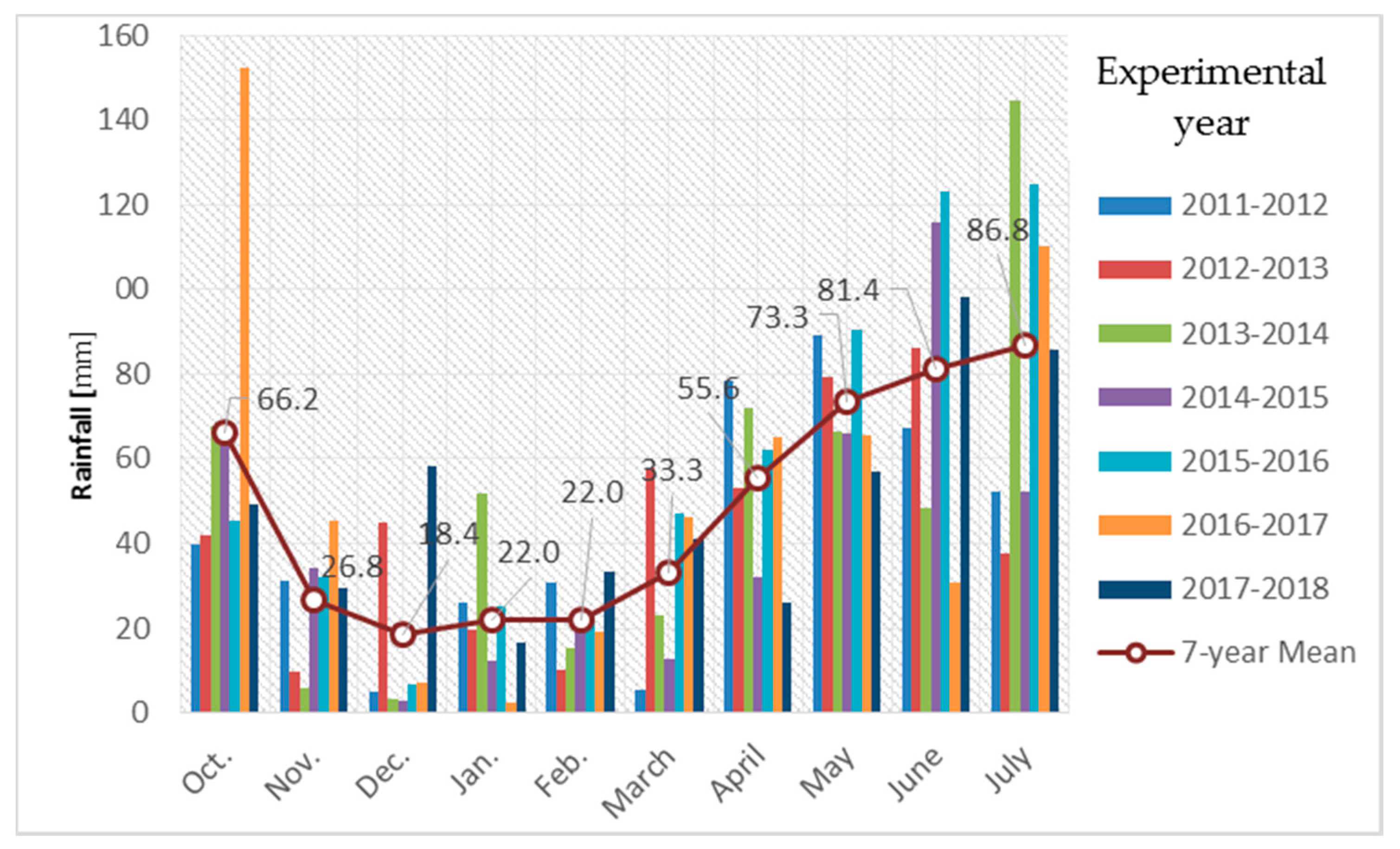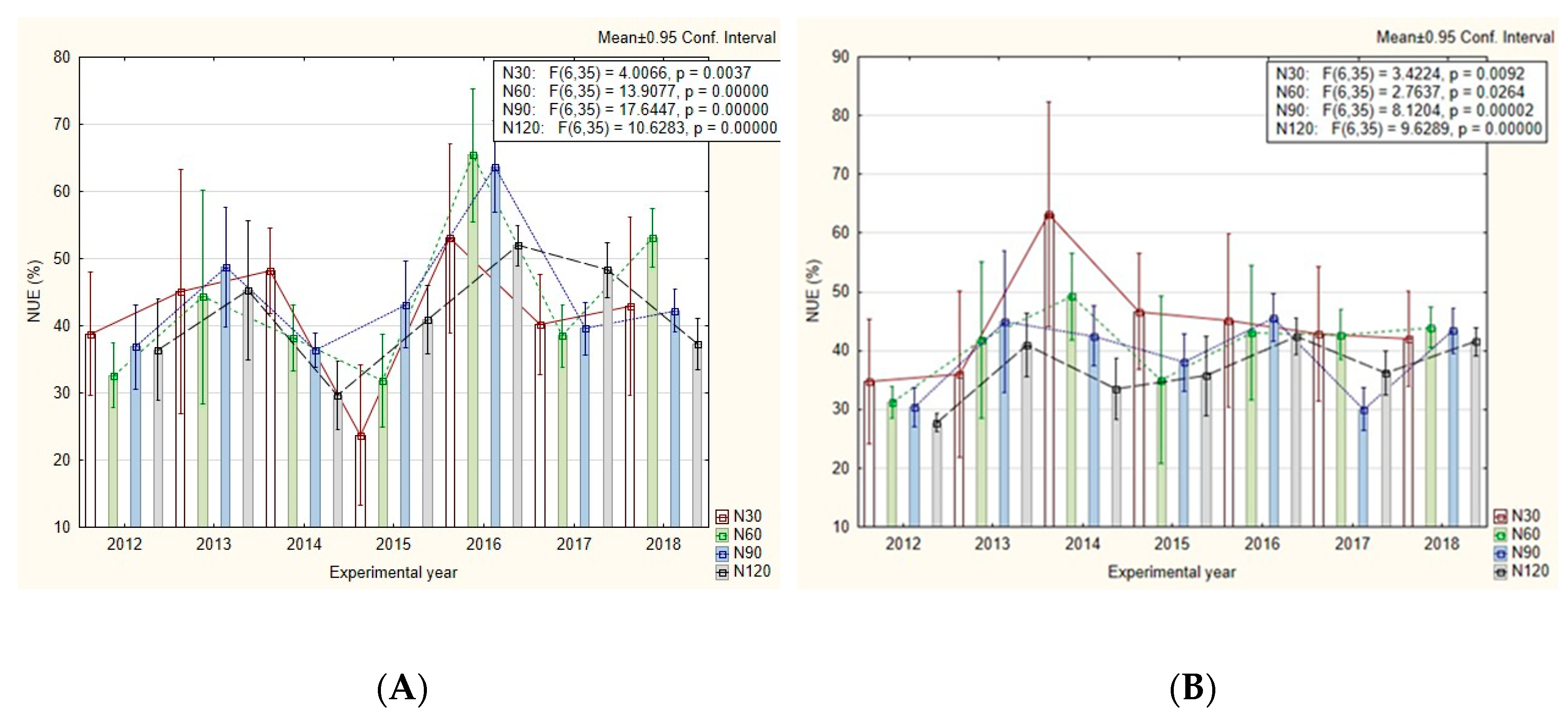Assessing Wheat Response to N Fertilization in a Wheat–Maize–Soybean Long-Term Rotation through NUE Measurements
Abstract
:1. Introduction
2. Materials and Methods
2.1. Study Site
2.2. Experimental Set Up
2.3. Grain Yield and Crude Protein Content
2.4. Plant N Uptake, Nitrogen Use Efficiency and Partial Factor Productivity
2.5. Statistical Analyses
3. Results
3.1. Grain Yield and Crude Protein Content
| Factor | Factor Level | GY (kg ha−1 y−1) |
|---|---|---|
| Planting pattern | WM | 4867 a |
| WS | 5391 b | |
| N fertilization | 0 | 3565 a |
| 30 | 4682 b | |
| 60 | 53656 c | |
| 90 | 5987 c | |
| 120 | 6080 c | |
| Experimental year | 2012 | 4465 a |
| 2013 | 4657 b | |
| 2014 | 5667 a | |
| 2015 | 55307 a | |
| 2016 | 5746 b | |
| 2017 | 4899 a | |
| 2018 | 48419 b | |
| Interaction WM × N fertilization ** | ||
| Interaction WS × N fertilization ** | ||
| Factor | Factor Level | CP (%) |
|---|---|---|
| Planting pattern | WM | 11.11 a |
| WS | 11.24 b | |
| N fertilization | 0 | 9.31 a |
| 30 | 10.10 b | |
| 60 | 11.25 c | |
| 90 | 12.22 d | |
| 120 | 12.97 e | |
| Experimental year | 2012 | 11.16 a |
| 2013 | 11.80 a | |
| 2014 | 10.65 b | |
| 2015 | 10.45 b | |
| 2016 | 12.04 b | |
| 2017 | 10.92 b | |
| 2018 | 11.22 b |
3.2. Plant N Uptake, Nitrogen Use Efficiency (NUE) and Partial Factor Productivity (PFP)
4. Discussion
5. Conclusions
Author Contributions
Funding
Acknowledgments
Conflicts of Interest
References
- Mălinaș, A.; Rotar, I.; Vidican, R.; Păcurar, F.; Iuga, V.; Mălinaș, C.; Moldovan, C.M. Designing a sustainable temporary grassland system by monitoring the Nitrogen Use Efficiency. Agronomy 2020, 10, 644. [Google Scholar] [CrossRef] [Green Version]
- European Commission (E.C.). European Green Deal. Available online: https://ec.europa.eu/info/sites/info/files/european-green-deal-communication_en.pdf (accessed on 26 March 2020).
- Ingram, J. Perspective: Look beyond production. Nature 2017, 544, 5–17. [Google Scholar] [CrossRef] [PubMed]
- Lestingi, A.; Ventrella, D.; Bovera, F.; De Giorgio, D.; Tateo, A. Effects of tillage and nitrogen fertilization on triticale grain yield, chemical composition and nutritive value. J. Sci. Food Agric. 2010, 90, 2440–2446. [Google Scholar] [CrossRef]
- Averbeke, W.V.; Denison, J.; Mnkeni, P.N.S. Smallholder irrigation schemes in South Africa: A review of knowledge generated by the Water Research Commission. Water SA 2011, 37, 797. [Google Scholar] [CrossRef] [Green Version]
- Delogu, G.; Cattivelli, L.; Pecchioni, N.; De Falcis, D.; Maggiore, T.; Stanca, A.M. Uptake and agronomic efficiency of nitrogen in winter barley and winter wheat. Eur. J. Agron. 1998, 9, 11–20. [Google Scholar] [CrossRef]
- Novoa, R.; Loomis, R.S. Nitrogen and plant production. Plant. Soil. 1981, 58, 177–204. [Google Scholar] [CrossRef]
- Cassman, K.G.; Dobermann, A.; Walters, D.T. Agroecosystems, nitrogen-use efficiency, and nitrogen management. Ambio 2002, 31, 132–140. [Google Scholar] [CrossRef]
- Dobermann, A. Nitrogen Use Efficiency—State of the Art. Agron. Horti—Faculty Publications. Available online: https://digitalcommons.unl.edu/cgi/viewcontent.cgi?referer=&httpsredir=1&article=1319&context=agronomyfacpub (accessed on 20 March 2020).
- Fixen, P.; Brentrup, F.; Bruulsema, T.; Garcia, F.; Norton, R.; Zingore, S. Nutrient/fertilizer use efficiency: Measurement, current situation and trends. In Managing Water and Fertilizer for Sustainable Agricultural Intensification, 1st ed.; Drechsel, P., Heffer, P., Magen, H., Mikkelsen, R., Wichelns, D., Eds.; International Fertilizer Industry Association (IFA); International Water Management Institute (IWMI); International Plant Nutrition Institute (IPNI); International Potash Institute (IPI): Paris, France, 2015. [Google Scholar]
- Zhao, R.-F.; Chen, X.-P.; Zhang, F.-S.; Zhang, H.; Schroder, J.; Volker, R. Fertilization and Nitrogen Balance in a Wheat–Maize Rotation System in North China. Agron. J. 2006, 98, 938–945. [Google Scholar] [CrossRef]
- Hiremath, A.J.; Ewel, J.J. Ecosystem nutrient use efficiency, productivity, and nutrient accrual in model tropical communities. Ecosystems 2001, 4, 669–682. [Google Scholar] [CrossRef]
- Dobermann, A.; Cassman, K.G.; Waters, D.T.; Witt, C. Balancing short- and long-term goals in nutrient management. In Proceedings of the XV International Plant Nutrient Colloquium, Beijing, China, 14–16 September 2005. [Google Scholar]
- Peoples, M.B.; Brockwell, J.; Herridge, D.F.; Rochester, I.J.; Alves, B.J.R.; Urquiaga, S.; Boddey, R.M.; Dakora, F.D.; Bhattarai, S.; Maskey, S.L.; et al. The contributions of N-fixing crop legumes to the productivity of agricultural systems. Symbiosis 2009, 48, 1–17. [Google Scholar] [CrossRef]
- Alhajj, S.; Luigi Tedone, A.; Verdini, L.; Cazzato, E.; De Mastro, G. Wheat Response to No-Tillage and Nitrogen Fertilization in a Long-Term Faba Bean-Based Rotation. Agron. J. 2019, 9, 50. [Google Scholar]
- Bedoussac, L.; Justes, E. The efficiency of a durum wheat-winter pea intercrop to improve yield and wheat grain protein concentration depends on N availability during early growth. Plant. Soil. 2010, 330, 19–35. [Google Scholar] [CrossRef]
- Gaudin, A.C.M.; Janovicek, K.; Deen, B.; Hooker, D.C. Wheat improves nitrogen use efficiency of maize and soybean-based cropping systems. Agric. Ecosyst. Environ. 2015, 210, 1–10. [Google Scholar] [CrossRef]
- Lebender, U.; Senbayram, M.; Lammel, J.; Kuhlmann, H. Effect of mineral nitrogen fertilizer forms on N O emissions from arable soils in winter wheat production. J. Soil. Sci. Plant Nutr. 2014, 177, 722–732. [Google Scholar] [CrossRef]
- Peoples, M.B.; Boyer, E.W.; Goulding, K.W.T.; Heffer, P.; Ochwoh, V.A.; Vanlauwe, B.; Wood, S.; Yagi, K.; Van Cleemput, O. Pathways of nitrogen loss and their impact on human health and the environment. In Agriculture and the Nitrogen Cycle: Assessing the Impacts of Fertilizer Use on Food Production and the Environment; Mosier, A.R., Syers, J.K., Freney, J.R., Eds.; Island Press: Washington, DC, USA, 2004; pp. 53–69. [Google Scholar]
- Syswerda, S.P.; Basso, B.; Hamilton, S.K.; Tausig, J.B.; Robertson, G.P. Long-term nitrate loss along an agricultural intensity gradient in the Upper Midwest USA. Agric. Ecosyst. Environ. 2012, 149, 10–19. [Google Scholar] [CrossRef] [Green Version]
- Goulding, K.; Jarvis, S.; Whitmore, A. Optimizing nutrient management for farm systems. Philos. Trans. R. Soc. Lond. B Biol. Sci. 2008, 363, 667–680. [Google Scholar] [CrossRef] [Green Version]
- Faostat. Available online: http://www.fao.org/faostat/en/#data/QC (accessed on 29 March 2020).
- Available online: https://www.madr.ro/culturi-de-camp/cereale/grau.html (accessed on 29 March 2020).
- Kjeldahl, J. Neue Methods zur Bestimmung des Stickstoffs in Organischen Korpern. Z. Anal. Chem. 1983, 22, 366–382. [Google Scholar] [CrossRef] [Green Version]
- Moll, R.H.; Kamprath, E.J.; Jackson, W.A. Analysis and interpretation of factors which contribute to efficiency of nitrogen utilization. Agron. J. 1982, 74, 562–564. [Google Scholar] [CrossRef]
- Dobermann, A. Nutrient use efficiency—measurement and management. In Proceedings of the IFA International Workshop on Fertilizer Best Management Practices, Brussels, Belgium, 7–9 March 2007; pp. 1–28. [Google Scholar]
- Suciu, A.; Miclea, R.; Sopterean, L.; Kadar, R.; Haş, I.; Puia, C. Comportarea unor soiuride grâu în diferite condiţii de infecţie cu Fusarium spp. I.N.C.D.A. Fundulea 2014, LXXXII, 61-3-68. [Google Scholar]
- Luo, Q. Temperature thresholds and crop production: A review. Clim. Chang. 2011, 1095, 83–98. [Google Scholar] [CrossRef]
- Tubiello, F.N.; Soussana, J.-F.; Howden, S.M. Crop and pasture response to climate change. Proc. Natl. Acad. Sci. USA 2007, 104, 19686–19690. [Google Scholar] [CrossRef] [PubMed] [Green Version]
- Wheeler, T.R.; Craufurd, P.Q.; Ellis, R.H.; Porter, J.R.; Vara Prasad, P. Temperature variability and the yield of annual crops. Agric. Ecosyst. Environ. 2000, 821, 59–67. [Google Scholar] [CrossRef]
- Curtis, B.C. Wheat in the world. In Bread Wheat: Improvement and Production; Curtis, B.C., Rajaram, S., Gómez, H., Eds.; Food and Agriculture Organization of the United Nations: Rome, Italy, 2002; pp. 7–10. [Google Scholar]
- Anastasi, U.; Corinzia, S.A.; Cosentino, S.L.; Scordia, D. Performances of Durum Wheat Varieties under Conventional and No-Chemical Input Management. Agronomy 2019, 9, 788. [Google Scholar] [CrossRef] [Green Version]
- Quaranta, F.; Amoriello, T.; Aureli, G.; Belocchi, A.; D’Egidio, M.G.; Fornara, M.; Melloni, S.; Desidrio, E. Grain yield, quality and deoxynivalenol (DON) contamination of durum wheat (Triticum durum Desf.): Results of national networks in organic and conventional cropping systems. Ital. J. Agron. 2010, 4, 353–366. [Google Scholar]
- Wang, Z.-H.; Xiu, S.L.; Malhi, S. Effects of fertilization and other agronomic measures on nutritional quality of crops. J. Sci. Food Agric. 2008, 88, 7–23. [Google Scholar] [CrossRef]
- Thompson, H. Food science deserves a place at the table—US agricultural research chief aims to raise the profile of farming and nutrition science. Nature 2012. Available online: https://www.nature.com/news/food-science-deserves-a-place-at-the-table-1.10963 (accessed on 25 March 2020).
- Noureldin, N.A.; Saudy, H.S.; Ashmawy, F.; Saed, H.M. Grain yield response index of bread wheat cultivars as influenced by nitrogen levels. Ann. Agric. Sci. 2013, 58, 147–152. [Google Scholar] [CrossRef]
- Omara, P.; Aula, L.; Oyebiyi, F.; Raun, W.R. World Cereal Nitrogen Use Efficiency Trends: Review and Current Knowledge. Agrosyst. Geosci. Environ. 2019, 2, 1–8. [Google Scholar] [CrossRef]
- Raun, W.R.; Johnson, G.V. Improving Nitrogen Use Efficiency for Cereal Production. Agron. J. 1999, 91, 357–363. [Google Scholar] [CrossRef] [Green Version]
- Evans, A. Nitrogen use efficiency (NUE) and tools for farmer engagement: A good reason for being imprecise. In Proceedings of the 2016 International Nitrogen Initiative Conference, Solutions to Improve Nitrogen Use Efficiency for the World, Melbourne, Australia, 4–8 December 2016. [Google Scholar]




| Agrochemical Index | Value |
|---|---|
| pH in H2O | 6.81 |
| Humus (%) | 3.73 |
| Total nitrogen (Nt; %) | 0.205 |
| P (ppm) | 47 |
| K (ppm) | 320 |
| Factor | Factor Level | N Uptake (kg N ha−1 y−1) | NUE (%) | PFP (kg grain kg N−1) |
|---|---|---|---|---|
| Planting pattern | WM | 95.68 a | 42.73 a | 85.65 a |
| WS | 105.66 b | 40.38 b | 94.24 b | |
| N fertilization | 0 | 51.93 a | N.F. | N.F. |
| 30 | 82.60 b | 43.04 a | 155.25 a | |
| 60 | 104.90 c | 42.22 b | 88.46 b | |
| 90 | 126.37 c | 41.83 c | 65.69 c | |
| 120 | 137.57 c | 39.15 d | 50.40 d | |
| Experimental year | 2012 | 87.56 *** | 33.68 a | 80.30 a |
| 2013 | 99.52 *** | 43.41 b | 81.01 b | |
| 2014 | 108.34 *** | 42.61 c | 102.64 c | |
| 2015 | 103.39 *** | 36.88 d | 96.83 d | |
| 2016 | 123.53 *** | 51.30 e | 101.94 e | |
| 2017 | 87.07 *** | 39.78 f | 81.93 f | |
| 2018 | 95.30 *** | 43.31 g | 84.98 g |
© 2020 by the authors. Licensee MDPI, Basel, Switzerland. This article is an open access article distributed under the terms and conditions of the Creative Commons Attribution (CC BY) license (http://creativecommons.org/licenses/by/4.0/).
Share and Cite
Vidican, R.; Mălinaș, A.; Rotar, I.; Kadar, R.; Deac, V.; Mălinaș, C. Assessing Wheat Response to N Fertilization in a Wheat–Maize–Soybean Long-Term Rotation through NUE Measurements. Agronomy 2020, 10, 941. https://doi.org/10.3390/agronomy10070941
Vidican R, Mălinaș A, Rotar I, Kadar R, Deac V, Mălinaș C. Assessing Wheat Response to N Fertilization in a Wheat–Maize–Soybean Long-Term Rotation through NUE Measurements. Agronomy. 2020; 10(7):941. https://doi.org/10.3390/agronomy10070941
Chicago/Turabian StyleVidican, Roxana, Anamaria Mălinaș, Ioan Rotar, Rozalia Kadar, Valeria Deac, and Cristian Mălinaș. 2020. "Assessing Wheat Response to N Fertilization in a Wheat–Maize–Soybean Long-Term Rotation through NUE Measurements" Agronomy 10, no. 7: 941. https://doi.org/10.3390/agronomy10070941




